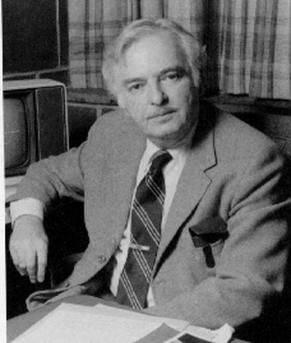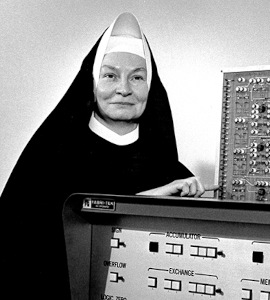
BASIC is a family of general-purpose, high-level programming languages designed for ease of use. The original version was created by John G. Kemeny and Thomas E. Kurtz at Dartmouth College in 1963. They wanted to enable students in non-scientific fields to use computers. At the time, nearly all computers required writing custom software, which only scientists and mathematicians tended to learn.

Fortran is a third generation, compiled, imperative programming language that is especially suited to numeric computation and scientific computing.

True BASIC is a variant of the BASIC programming language descended from Dartmouth BASIC—the original BASIC. Both were created by college professors John G. Kemeny and Thomas E. Kurtz.
MAD is a programming language and compiler for the IBM 704 and later the IBM 709, IBM 7090, IBM 7040, UNIVAC 1107, UNIVAC 1108, Philco 210-211, and eventually IBM System/370 mainframe computers. Developed in 1959 at the University of Michigan by Bernard Galler, Bruce Arden and Robert M. Graham, MAD is a variant of the ALGOL language. It was widely used to teach programming at colleges and universities during the 1960s and played a minor role in the development of Compatible Time-Sharing System (CTSS), Multics, and the Michigan Terminal System computer operating systems. The original version of the chatbot ELIZA was written in MAD-SLIP.
BBC BASIC is an interpreted version of the BASIC programming language. It was developed by Acorn Computers Ltd when they were selected by the BBC to supply the computer for their BBC Literacy Project in 1981.
Dartmouth BASIC is the original version of the BASIC programming language. It was designed by two professors at Dartmouth College, John G. Kemeny and Thomas E. Kurtz. With the underlying Dartmouth Time Sharing System (DTSS), it offered an interactive programming environment to all undergraduates as well as the larger university community.
TOPS-10 System is a discontinued operating system from Digital Equipment Corporation (DEC) for the PDP-10 mainframe computer family. Launched in 1967, TOPS-10 evolved from the earlier "Monitor" software for the PDP-6 and PDP-10 computers; this was renamed to TOPS-10 in 1970.

John George Kemeny was a Hungarian-born American mathematician, computer scientist, and educator best known for co-developing the BASIC programming language in 1964 with Thomas E. Kurtz. Kemeny served as the 13th President of Dartmouth College from 1970 to 1981 and pioneered the use of computers in college education. Kemeny chaired the presidential commission that investigated the Three Mile Island accident in 1979. According to György Marx he was one of The Martians.
The Dartmouth Time-Sharing System (DTSS) is a discontinued operating system first developed at Dartmouth College between 1963 and 1964. It was the first successful large-scale time-sharing system to be implemented, and was also the system for which the BASIC language was developed. DTSS was developed continually over the next decade, reimplemented on several generations of computers, and finally shut down in 1999.
ALGOL 60 is a member of the ALGOL family of computer programming languages. It followed on from ALGOL 58 which had introduced code blocks and the begin and end pairs for delimiting them, representing a key advance in the rise of structured programming. ALGOL 60 was one of the first languages implementing function definitions. ALGOL 60 function definitions could be nested within one another, with lexical scope. It gave rise to many other languages, including CPL, PL/I, Simula, BCPL, B, Pascal, and C. Practically every computer of the era had a systems programming language based on ALGOL 60 concepts.

The history of programming languages spans from documentation of early mechanical computers to modern tools for software development. Early programming languages were highly specialized, relying on mathematical notation and similarly obscure syntax. Throughout the 20th century, research in compiler theory led to the creation of high-level programming languages, which use a more accessible syntax to communicate instructions.
In computer science, a relational operator is a programming language construct or operator that tests or defines some kind of relation between two entities. These include numerical equality and inequalities.
Dartmouth ALGOL 30 was a 1960s-era implementation, first of the ALGOL 58 programming language and then of ALGOL 60. It is named after the computer on which it ran: a Librascope General Precision (LGP-30) desk-size computer acquired by Dartmouth College in 1959.

Mary Kenneth Keller, B.V.M. was an American Catholic religious sister, educator and pioneer in computer science. She was the first person to earn a Ph.D. in computer science in the United States. Keller and Irving C. Tang were the first two recipients of computer science doctorates.
Mainframe computers are computers used primarily by businesses and academic institutions for large-scale processes. Before personal computers, first termed microcomputers, became widely available to the general public in the 1970s, the computing industry was composed of mainframe computers and the relatively smaller and cheaper minicomputer variant. During the mid to late 1960s, many early video games were programmed on these computers. Developed prior to the rise of the commercial video game industry in the early 1970s, these early mainframe games were generally written by students or employees at large corporations in a machine or assembly language that could only be understood by the specific machine or computer type they were developed on. While many of these games were lost as older computers were discontinued, some of them were ported to high-level computer languages like BASIC, had expanded versions later released for personal computers, or were recreated for bulletin board systems years later, thus influencing future games and developers.
DARSIMCO, short for Dartmouth Simplified Code, was a simple programming language written by John Kemeny in 1956 that expanded simple mathematical operations into IBM 704 assembly language. It was an attempt to simplify basic mathematical processing, a common theme in the 1950s, but found little use before the arrival of FORTRAN at MIT the next year.
DOPE, short for Dartmouth Oversimplified Programming Experiment, was a simple programming language designed by John Kemény in 1962 to offer students a transition from flow-charting to programming the LGP-30. Lessons learned from implementing DOPE were subsequently applied to the invention and development of BASIC.

Donald Lester Kreider was an American mathematician and educator who served as president of the Mathematical Association of America (1993–1994).
Full BASIC, sometimes known as Standard BASIC or ANSI BASIC, is an international standard defining a dialect of the BASIC programming language. It was developed by the American National Standards Institute (ANSI) X3.60 group in partnership with the European ECMA. It describes an advanced version of BASIC with many features including structured programming, matrix math, input/output for file handling, and many other options.
CALL/360:BASIC was an IBM dialect of the BASIC programming language for the System/360 and later platforms. It was based on mid-1960s versions of Dartmouth BASIC but added a number of extensions. Most of these were related to file handling, which, at that time, Dartmouth lacked. It also added support for the mathematical symbols found on some IBM terminals, so that <= could be entered directly as ≤. Differences are otherwise minor.








